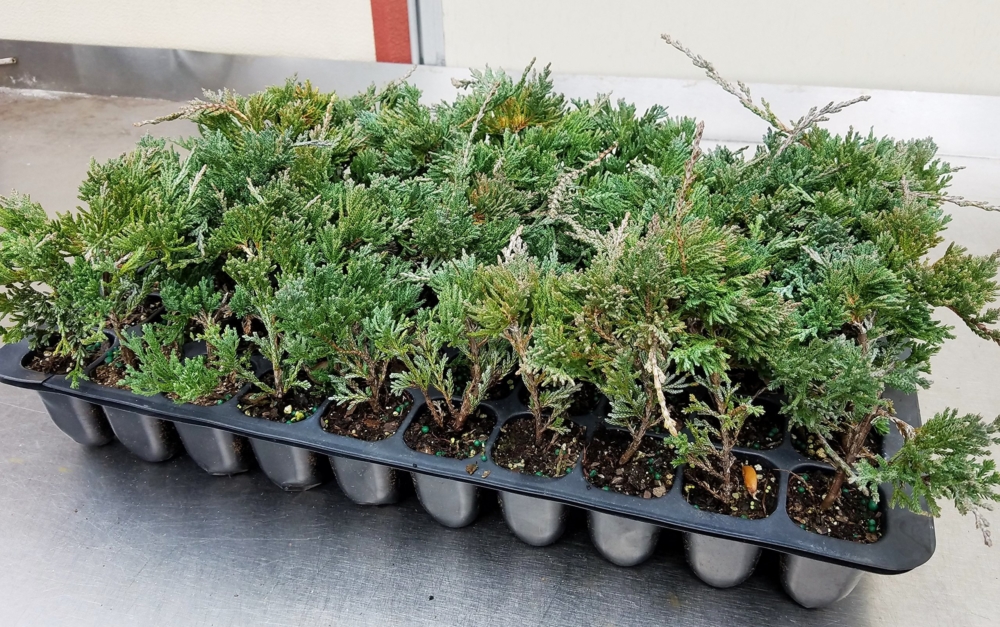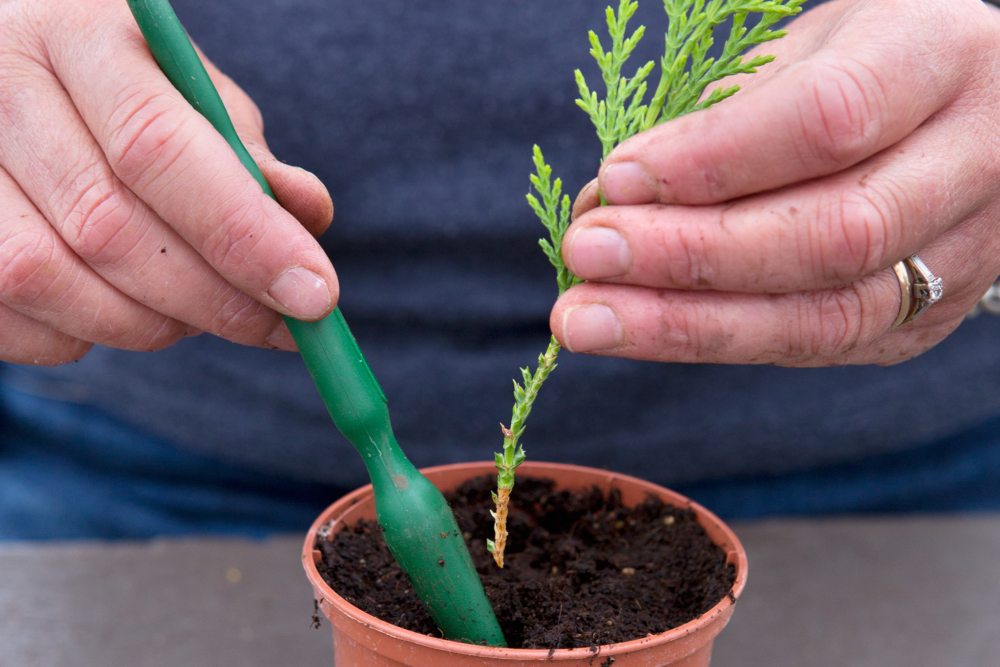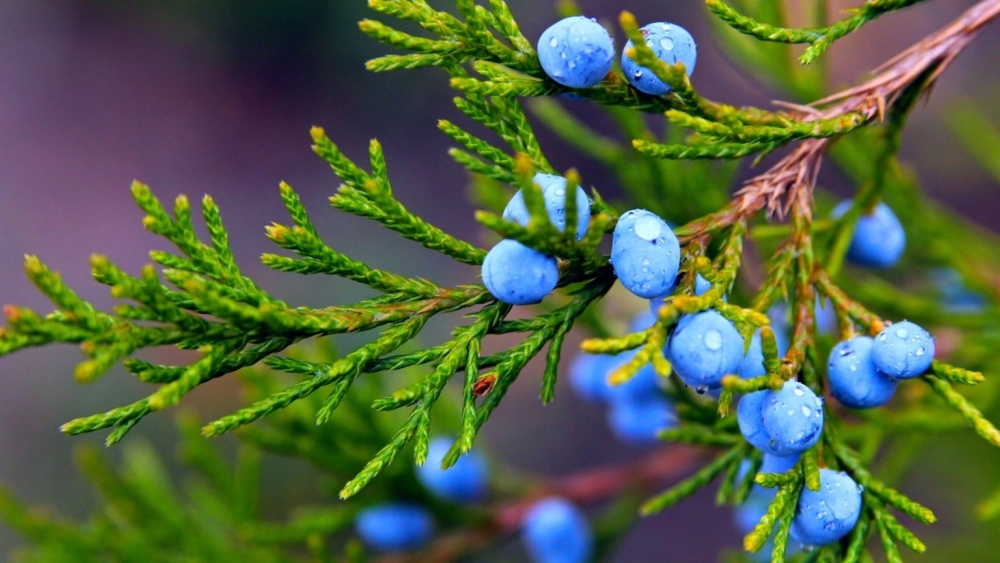Juniper is an evergreen coniferous shrub. They are also called “heather” or “juniper”. They are also found in the form of cypress trees. If the gardener decided to plant such plants on his site, it will be useful for him to study the question: how to propagate juniper.
Material Content:
Description and characteristics of the plant
Juniper can be found in the form of bushes or trees. Interestingly, it was mentioned in the writings of ancient Roman poets. Today, the name "juniper" immediately combines more than 65 species of different plant species. If creeping most often occurs precisely in mountainous regions, then trees also grow in the forests of America, Central Asia, and the Mediterranean. Outwardly, the latter are similar to cypresses and are able to live up to 3 thousand years. You can be sure that where juniper grows and develops, there is always incredibly clean air.
Various parts of such a plant have long been used in medicine. For example, earlier it was the first remedy against snake bites, and today a huge amount of medicines against various ailments is made from cones, berries, and culture roots. In Russia, juniper was used to make unique dishes in which dairy products remained fresh for a very long time, even on a hot day. Today, the fruits of the plant are actively used in cooking, for example, as a seasoning for meat or for making soups, liquors, marinades. Stunning crafts, as well as pencils, are created from the wood of some types of juniper.
Among gardeners, the plant in question is more popular in the form of shrubs. At the same time, its height can still reach 2-3 meters. You can plant juniper both in the garden and at home. It tolerates wintering well, therefore it is suitable for different regions of Russia. But in cold weather it is recommended to cover the plants with spruce branches.
Today, almost every nursery for gardeners sells juniper seedlings. Therefore, many summer residents go the simplest way and do not decide on their own propagation of juniper. This is not an easy process due to the peculiarities of its structure, growth and development. The plant “loves” acidic soil, but can also breed on sandy soil. The older it gets, the better it survives the Russian cold.
A quick and easy way to propagate juniper
Juniper paid for its amazing longevity by slow growth and difficulties with reproduction. But such difficulties do not stop real gardeners.
The fastest and easiest method of propagation of juniper today is the use of cuttings. Therefore, gardeners resort to it most often.
If it is planned to propagate the juniper with cuttings in the spring, then they should be cut off already in early February. If the main process is to fall in autumn, then cuttings are prepared at the very beginning of summer. These recommendations must be taken into account, since the roots of the plant will begin to appear only after 20-25 days. And for complete rooting it will take about 2 months at all. Need to remember that when cutting the cuttings in the summer until next spring, the plant will have to be kept in a warm place or at least carefully protected from frost.
Material for further planting should be taken from the top of the bush / tree. In no case should it be woody. The slice is performed in the dark or on a cloudy day. In the process, shoots of 20-25 cm in length are carefully removed with a sharp knife. Below, at a distance of about 5 cm, the bark and branches are removed. It is in this part that the roots will appear. You can’t store the branches (a maximum of a couple of hours in water), they must immediately be planted in a mixture of peat and humus taken in equal portions. It is also necessary to make a drainage layer of small pebbles, sand.
Cuttings are deepened by a maximum of 3 cm. Between them there should be a distance of about 1 m. Only for creeping varieties shoots are planted horizontally, for all others - vertically. Only scattered light should fall on the plant, direct sunlight for shoots is contraindicated. It is best to spray seedlings so as not to overdo it with moisture. Already in late summer / early autumn they can be sent to the open ground.
Seedlings are sent to a permanent place 3 months after planting in seedling boxes. In this case, you need to be as careful as possible with tender young roots. And the best thing is to let the plants winter at home or in the greenhouse.
Options for different types and varieties
If you want to propagate a creeping plant variety (for example, Green Carpet, Blue Chip, Cossack Juniper), then you need to use the second most popular method - reproduction by bends. The procedure will continue throughout the growing season of the plant.
First of all, you need to thoroughly loosen the soil and water the mother plant abundantly. And then:
- Choose a healthy young escape.
- Bare his heel by 10-20 cm.
- Press the prepared shoot to the ground and secure with wire. It is very convenient to do this with an ordinary female hairpin.
- Mulch the attached branch with humus. Instead of the latter, peat can also be used.
The young plant must be constantly carefully looked after, for example, watered and spud. As soon as the root system appears, it's time to separate the layers from the mother instance, arrange a transplant to a permanent place, pre-selected for the plant. But it will take a long time to wait - about 10-12 months.Therefore, when propagating the plants, layering will have to be patient.
The method of propagation of juniper seeds is used extremely rarely. Indeed, in this way it is practically impossible to obtain a plant of a decorative appearance. It is suitable only for the most common common crops.
It is necessary to collect seeds from a plant (3-5 years old), germinate them and only after that plant them in the ground. They will need to be "hidden" very deeply. Shoots appear after about 35 months. In order not to wait so long, you can choose a seedling method for yourself. For him, the collected material for an hour is poured with a growth stimulator. Then - it is planted in a mixture of needles and leafy earth. Only when the seedlings have already grown enough and become strong, strong, you can perform a pick.
The vaccination propagation method is used when working with particularly valuable plant varieties. They are grafted to the common juniper. To do this, the graft (shoot), neatly cut with a sharp knife, is firmly pressed against the stock. The junction of two plants is thus securely fixed with a piece of plastic film. It should be noted right away that the graft takes root only in rare cases, therefore this method is very rarely used by gardeners.
Features of breeding at home
Juniper seed can be planted at home. It is most convenient to use wooden boxes for this, which need to be filled with nutritious soil. It is best to also add a portion of soil from under an already adult plant. After all, it will contain mushrooms important for the growth of juniper.
It should be noted right away that it will be extremely difficult for a plant to survive and stay healthy in conditions of hot, dry room air. In this case, it will have to be protected with plastic wrap.
In summer, the juniper at home should stand on the northern windowsill, and in winter - on the south. In general, the temperature in the room should not exceed 20 degrees. Therefore, in summer it is better to take the plant to the balcony.
If the propagation of juniper is carried out by seeds at home, then boxes with them and soil also need to be taken outside and left in the cold and open air for 4 months. Only after that - transplant into pots. When propagated by cuttings, containers with them are located in the darkened area of the house and covered with a film. After about 2-2.5 months, seedlings with already strong roots are transplanted into flowerpots. During the rooting period, they must be sprayed.
What problems can be encountered
There are several common problems that a gardener may encounter when trying to propagate juniper. For example, due to exposure to dry winter air, seedlings can weaken greatly or even die altogether. They are also difficult to tolerate sunburn.
If yellowed dying needles are seen on the branches of a plant, these parts must be cut off. So manifested various diseases of juniper. The remaining parts of the plant after pruning are sprayed with fungicides.
Very destructive for juniper of any age and scale, caterpillar shoot moths, sawfly. Insecticides help get rid of them.
Reproduction of juniper is a difficult and lengthy process. Therefore, you need to be patient and carefully follow the advice of specialists.
















